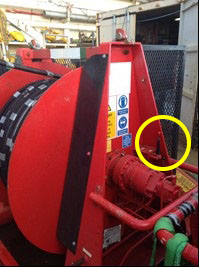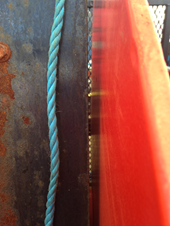Hydraulic umbilical winch operation – trapped thumb
A member has reported an incident in which a member of the deck crew injured their thumb while operating a hydraulic umbilical winch. The vessel deck crew were recovering hydraulic power hoses from subsea onto a hydraulic umbilical winch drum, when the winch operator trapped his thumb between the safety guard and the drum. The operator was wearing the correct personal protective equipment (PPE) for the task. After the incident, the operator removed his glove and noticed a small amount of blood; he reported the incident immediately to his supervisor who in turn contacted the medic. The extent of the injury was a small abrasion to the left hand and the thumbnail had lifted.





Our member’s investigation noted the following:
- The operator was not in the correct location for operating the equipment. He was forward of the winch. The winch controls were located at the rear of equipment where adequate guarding was provided;
- The operator or any other person should not have had physical access to the moving parts (such that an entrapment is possible) regardless of their position. Persons working controls should ensure they were not in a place where they would be exposed to any risk to their health or safety as a result of the operation of those control;
- Gaps between the safety guards, located on the forward side of the winch, were found to vary in gap size ranging from 5mm to 15mm; it was found that the larger gap increased the risk of entrapment;
- The incident highlights the importance of having adequate guarding fitted to all equipment. It was found on this occasion that guarding can become a hazard in itself if gaps are not kept to a minimum. Subsequent checks on similar equipment located on other vessels highlighted further issues relating to the guarding provided;
- This incident highlights the requirement for guarding to be re-assessed on an ongoing basis during maintenance periods and during the completion of risk assessments.
Our member reports that the crew have made suggestions as to how to improve the guarding and these will be implemented onboard. The improvements were to add a strip of additional guarding in an effort to close the 15mm gap and in addition to this apply safety tape (as shown above) to highlight potential ‘pinch’ points to operators.
This is a reminder for all involved in tasks to watch out for pinch points and look out for one another at all times and to stop the job as required.
Please see the following IMCA safety promotional material:
- Line of fire (pocket card)
- Watch out for pinch points (poster)
- Slips, trips and finger nips (video)
Members may wish to refer to the following similar incidents (key word: pinch):
Safety Event
Published: 25 November 2014
Download: IMCA SF 18/14
IMCA Safety Flashes
Submit a Report
IMCA Safety Flashes summarise key safety matters and incidents, allowing lessons to be more easily learnt for the benefit of all. The effectiveness of the IMCA Safety Flash system depends on Members sharing information and so avoiding repeat incidents. Please consider adding [email protected] to your internal distribution list for safety alerts or manually submitting information on incidents you consider may be relevant. All information is anonymised or sanitised, as appropriate.
IMCA’s store terms and conditions (https://www.imca-int.com/legal-notices/terms/) apply to all downloads from IMCA’s website, including this document.
IMCA makes every effort to ensure the accuracy and reliability of the data contained in the documents it publishes, but IMCA shall not be liable for any guidance and/or recommendation and/or statement herein contained. The information contained in this document does not fulfil or replace any individual’s or Member's legal, regulatory or other duties or obligations in respect of their operations. Individuals and Members remain solely responsible for the safe, lawful and proper conduct of their operations.
